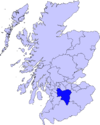Tarbrax
Tarbrax (Scottish Gaelic: "An Tòrr Breac" - meaning "the speckled tor") is a small village in the Parish of Carnwath, County of South Lanarkshire, Scotland. It is at the end of a dead end road off the A70 road between Edinburgh and Carnwath.
Tarbrax is 1000 feet above sea level on the edge of the Pentland Hills. Nearby villages include Auchengray and Woolfords.
Notable people from Tarbrax include writer Neil Cross
History

Tarbrax was built around a shale mine as housing for the miners beginning in the middle of the 19th Century. There is a large bing (spent shale spoil heap) in the village. The name is derived from the Lawhead Tarbrax estate within which it was built, which was then owned by David Souter Robertson, a founder of modern Accountancy. This estate was originally based around Tarbrax Castle, a seat of the Somervilles, though by 1649 it had passed to the Lockharts, including George Lockhart of Tarbrax. Nothing remains to be seen of the castle today. The village was a base for American GIs during the Second World War.
The war memorial is by Pilkington Jackson (1920).
Transport
Tarbrax once had its own mineral branch line and loading siding; the branch line led from Cobbinshaw railway station on the Caledonian Railway Edinburgh to Carstairs Line, north of Auchengray railway station. The principal traffic was in connection with shale oil extraction.
Education
Tarbrax formerly had its own school, in the days of the shale mining. The nearest local school now is a small primary in the neighbouring village of Auchengray, which takes children up to Primary 4; the four classes share two rooms. From Auchengray Primary School, children go on to Carnwath Primary School where they stay for three years before moving on to Biggar High School. All three schools are scheduled to be rebuilt in the next ten to fifteen years.
Tarbrax today
Wind farms have recently been built near Tarbrax, strongly opposed by some members of the local community when first proposed in 2006-2007, warmly welcomed by others. A further recent development is the village hall, which opened in 2004. It runs various groups and activities which include a Youth Club, Badminton group and an over-50s group. A committee of local people of all ages has formed to look into the problem of the football pitch and its surroundings which are considered unsightly, and plans have been made to improve the appearance of this area. As of late August 2012 work had begun by South Lanarkshire Council within the village common green to add drainage and allow for it be used by residents.
References
- The Castles of Scotland, Martin Coventry ISBN 978-1-84158-449-2

